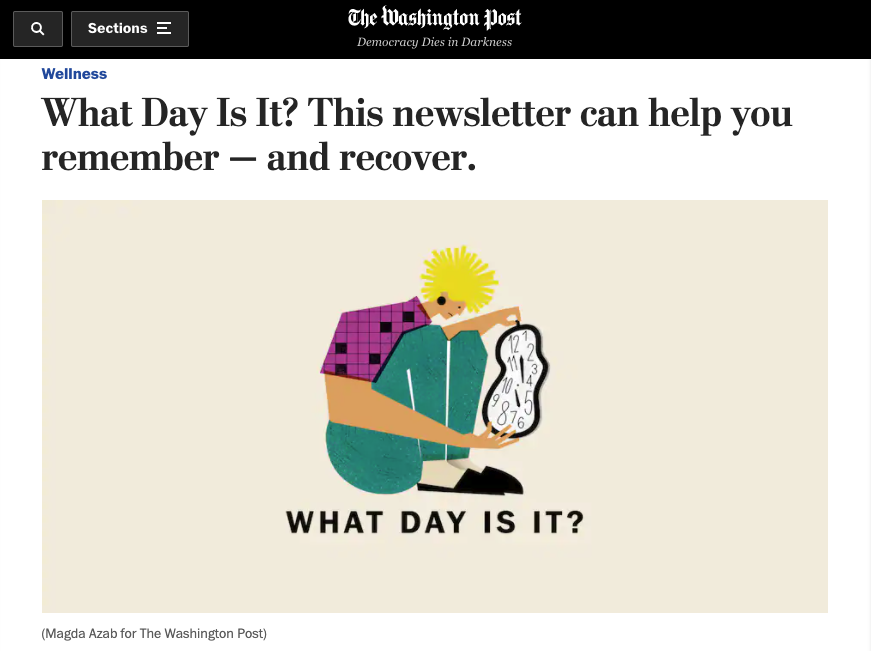This column originally appeared in The Cohort, Poynter’s newsletter by and for women in media. Subscribe here to join this community of trailblazers.
I’m writing this column at 2:30 a.m. on a Friday that feels like a Thursday. During the pandemic, I’ve adopted a habit of working whenever I feel like it. I stopped worrying about it months ago.
Humiliatingly enough, I assigned one of my direct reports the solution to this problem: “What Day Is It?”, a seven-day newsletter course that teaches people how to establish a routine during stressful times. With the newsletter, readers can download, fill out and share a new calendar for themselves. The author, Steven Johnson, wrote it as part of my team’s work conducting editorial experiments in the newsroom to help identify new opportunities, test strategies and provide recommendations to editors.
In the six weeks since the newsletter went live, we’ve learned a lot from how our readers responded, but we’re not done with testing. Here’s how we came up with and set up the experiment.
The idea
“What Day Is It?” actually started from a totally separate newsletter idea that, like everything else, got derailed by the pandemic. At the beginning of 2020, the team was assigned to identify opportunities in the wellness space. One of the topics we focused on was productivity: While many publications talk about productivity in terms of work, we found there was a chance to decenter it from work and focus it on people building the kind of lives they want, free of the condescending tone that can often come with self-improvement stories.
At the same time, the newsletter team was testing out more pop-up newsletters. My team saw a way to collaborate and help newsletter and wellness editors at the same time. I assigned team member Tom Johnson (not related to Steven Johnson) to work on a seven-issue email series about how to make the most of the time you have.
Coronavirus
The week Tom’s newsletter was supposed to launch, we learned that we would be working from home for the foreseeable future due to the novel coronavirus. With routines disrupted, our peppy anti-productivity productivity newsletter took on a menacing air.
Weeks later, the novelty of Zoom happy hours wore off and the days blurred. Everything I’d learned editing stories about productivity went out the window. My roommate put it best when she said: “It’s always Wednesday.”
We laughed, but it stuck with me. The pandemic is a perpetual hump day; we’re excited for the weekend but it still seems too far away. We thought we’d be at home for a month. Then three. And we’re still here.
The NEW idea
I had to manage the team through this temporal aimlessness. I deployed the team to work on new experiments and analyses focused on supporting our coronavirus work and informing on strategy.
But I wanted to try and salvage the work we lost when coronavirus shut the nation down, and our newsletter partners still wanted data on the daily course format. We set aside Tom’s work until our eventual return to our normal lives. We started brainstorming, and I told the group the “Wednesday” theory. That led us to discuss the perception of time and mental health. We worried it was somewhat abstract, but we thought it could be fun.
I assigned a new writer so that the voices would be distinct when we eventually published the original idea. Steven wrote seven new issues, and we commissioned new art and design. We launched in October, which now feels like it happened years ago.
Hypotheses and what we measure
When our team finishes an experiment, we publish a case study formatted around hypotheses, or assumptions, commissioning partners have about the story, format, audience or platform. Our partners in Wellness and newsletters were interested in open rates over time, paywall hits to the site and appealing to both new and loyal audiences.
What we’ve learned so far
As of Nov. 22, we’ve received tens of thousands of sign-ups, and the open rates are above average. So far, interest is sustained day after day, though we’ve identified some days that have larger drops. Since we’re still doing the experiment, we’re shoring up subject lines, and swapping out some links to improve recirculation.
We’ve found that even though much of this is conceptual, readers love having a tangible task to complete, and they appreciate how personal Steven gets as he works through the process with them.
We’re doing more tests to see if we can get new readers. I’d love for you to check out the course here, and tell us what you think!
For additional insights, community and ongoing conversations about women in digital media, sign up to receive The Cohort in your inbox every other Tuesday.







